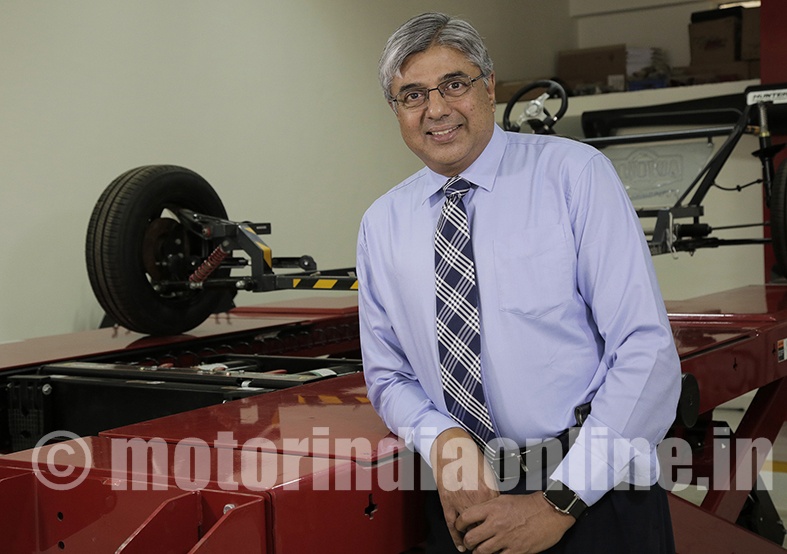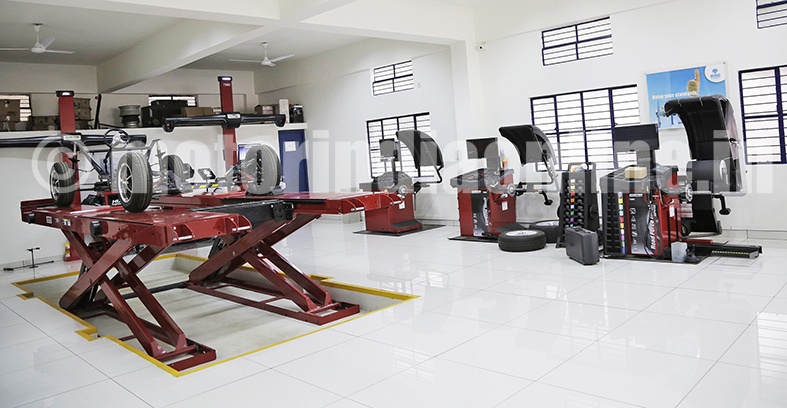By Ravi B.M., Managing Director, Madhus Garage Equipments
We see a lot of new things happening in the automobile sector, like a wider use of air bags for safety, and engines of lighter body but of higher efficiency to withstand a crash. Every manufacturer keeps talking about product features to sell his car.
If this is the outside of the car, what is happening under the car when you give it for maintenance? Have we progressed as much as we have done on outside?

I came into this line of garage equipment as I was always inquisitive about how things work and how to repair when it stops working – cycles, bikes, cars or machines. I have broken down things to learn how it works and restore them back to make them work again.
We had a tyre shop in 1981 and the way tyres were changed caught my attention. We imported the first mechanically assisted tyre changer, and this was a revolution at that time. We added a computerized aligner and balancer to kick-start a new era in garage equipment. The concept of balancing was non-existent at that time, with only threads and rods used for aligning wheels.
Lifts were unknown and only Elgi had a hydraulic in ground lift for car wash. Maruti changed the entire scene, followed by Ford, General Motors and Daewoo who came out with the concept of modern service using the latest technology, including pneumatic and electric tools. This gave comfort to the technicians and ensured higher productivity.
Car air-conditioning was a very big luxury, and by 1990 it was becoming a standard accessory. So equipment was required for servicing the same.
In the tyre industry, radial car tyres revolutionized the market. Balancing became a necessity and wheel alignment demand rose sharply. The Indian tyre industry rose to the occasion and was the first to make it available. Added to this the ROI was good for new comers to invest in opening shops which offered alignment, balancing and automatic tyre changing.
Dunlop, Ceat, Bridgestone, Michelin and MRF made it popular by encouraging their dealers to have these services offered at all their outlets.
On the other side, vehicle manufactures kept opening new workshops. But today when the car showrooms are at par  with those in other advanced countries, unfortunately the workshops are still way behind. They all still believe in low cost and take any amount spent as expenditure and not as investment. The bottomline is they earn the best part of their revenue in the workshop even if car sales slow down.
with those in other advanced countries, unfortunately the workshops are still way behind. They all still believe in low cost and take any amount spent as expenditure and not as investment. The bottomline is they earn the best part of their revenue in the workshop even if car sales slow down.
The garage equipment segment has grown by leaps and bounds. The best equipment is available in the country. At the same time, there is a lot of equipment inflow from China which is cheap and not durable as the quality and performance are way behind. But the price is low and that is all that matters to some customers.
Workshops are like our playback singers. No one sees them but everybody will either enjoy the good work or blame them for lousy work. The equipment makes a big difference in the quality of work that is finally delivered.
The garage equipment of today meets the advanced engineering features of today’s cars. Diagnostics are no longer dependent on the manpower. Everything is dependent on science and data collected from the many computers that run a car. Mechanically it is reaching a new high to assure safety and stability at very high speed.
Take for example a car of the 1980s. The ignition was with condenser and distributor with spark plugs. The fuel was supplied via the carburetor. Even small changes would stop the car. It would take an experienced person to understand and then strip some parts to arrive at a conclusion. Now the engines are controlled by a computer that decides how much fuel should be injected at what speed and can be set to different modes of driving with the touch of a button (Eco Drive, Speed Drive, etc.). Now to diagnose the new technology we need special tools to plug into the car to read all the data and analyze the problems.
The idea of a job done correctly the first time, to bring that smile on a customer’s face and the concept of delighting a customer is still a dream. In this aspect, the tyre industry is much better as its interaction with the customer is much more personal, while striving to optimise customer satisfaction.
Indian vehicle sales have just gone through the roof, making everyone think there is money for opening a dealership and selling cars has big margins. The bottom line is that the margins are there in service and not in sales of new cars. And they all hesitate to invest in service equipment but spend a fortune in showroom decoration. A customer visits the showroom once but the workshop many times. He comes back if only your workshop has good equipment and you provide good service. So, in this regard, we are still a decade behind advanced countries like the US, Europe and Japan.
Indian garage equipment has no standard of its own nor do they follow any other standards. For them a 2-post lift is another 2-post lift. Safety features, lifting capacity, etc., are not even checked or certified. Price is all that matters. In Europe or the US the lift manufacturer has to give his product to an agency that certifies that the product meets the safety standards, and if the label says it can lift 4 tons it is tested for 1:1.5 times its labelled load. Once certified, inspections are done regularly to ensure the lifts manufactured and sold meet these specifications.
In India, we are allowed to import from any country or manufacture it within the country. No one even checks it. Surprisingly, the dealers buy them without demanding this. So a lot of unbranded and uncertified equipment find its way into the market. Downtime and the cost of maintenance is not even tabulated to understand the return on investment.
We also have a very tolerant set of customers who do not question and demand quality for the money paid. When the equipment fails they defend the vendor by saying, “I paid very less, what else can I expect?”. This encourages more unauthorized vendors to mushroom and take advantage of the Indian market condition.
In the early 2000s we had many vendors who imported quality equipment from Europe, Japan and the US and sold it. Now most of them have chosen the easy way out by bringing in cheap and low quality equipment. The equipment quality has fallen over a period instead of going up. A sad state of affairs indeed!
Only the top-end vehicle manufacturers like Mercedes Benz, BMW, Audi and JLR, as also the tyre industry, are maintaining the quality, and this constitutes only around 25 per cent of the market. The rest have fallen on the way side, opting for low cost and unstandardized equipment.
I personally believe that this is a cycle and quality will be the focus in the coming years. My prediction is that by 2020 quality consciousness will sweep the market as the customer is getting smarter and he will go only where there is quality service backed by quality equipment. We already see this in the tyre industry, vehicle workshops will soon follow suit.